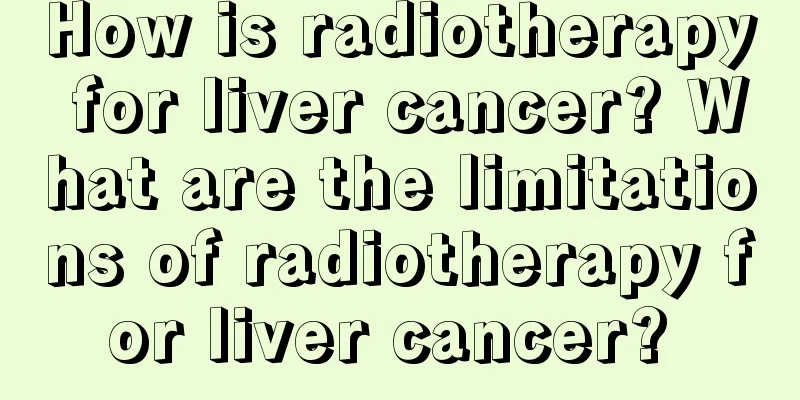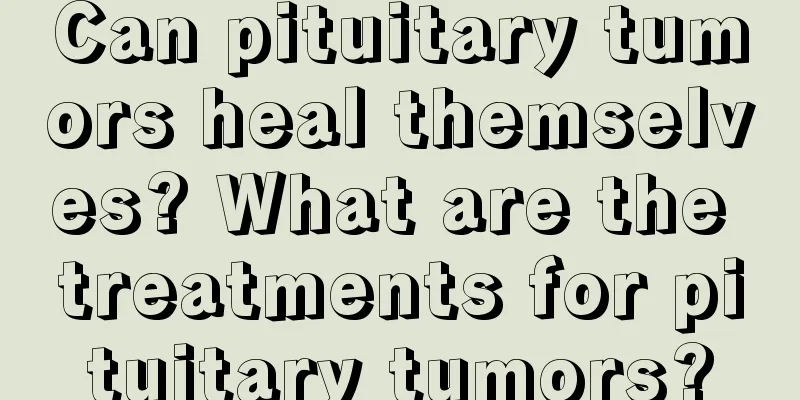How is radiotherapy for liver cancer? What are the limitations of radiotherapy for liver cancer?

|
Since the early 1920s, foreign countries have begun to explore radiotherapy for liver cancer. The conclusion of the study at that time was that it was dangerous to irradiate the liver, so there were almost no reports on radiotherapy for liver cancer. In the 1950s, reports on the efficacy of radiotherapy for liver cancer began to appear. In 1950, Pohle reported a case of giant liver cancer, which shrank to the point of being untouchable after radiotherapy and was relieved for 1 year. In 1956, Ariel pointed out in his report that due to the large blood flow in the liver, radiotherapy for liver cancer can be expected to be effective. If the cancer lesion is not large and the radiation field is not large, normal tissue can tolerate radiotherapy. In 1960, Phillps et al. reported that if the tumor irradiation dose is above 20Gy, the average survival time of liver cancer patients can be 12 months. However, some foreign literature in the second half of the 1960s mostly held a negative attitude towards radiotherapy for liver cancer. After the 1970s, there was a slight increase in foreign literature on the application of radiotherapy for liver cancer. However, until the 1990s, many authors still believed that radiotherapy for liver cancer was of little value. Let’s learn more about the specific situation with the experts online. Limitations of surgical treatment for liver cancer Although surgical treatment of liver cancer has made great progress in recent decades, only 10% to 15% of newly diagnosed liver cancer patients are suitable for surgery. At the same time, the recurrence rate of liver cancer patients after surgery is very high, and the treatment after tumor recurrence is relatively difficult. Surgical treatment can relatively cleanly remove the primary cancer lesions visible to the naked eye, but it cannot detect the invasion of cancer cells into the portal vein (hepatic vein) in the liver. Secondly, bleeding and squeezing during surgery can also cause local implantation of cancer cells and reach distant sites along the blood and lymphatic channels to form micro-metastasis lesions. In addition, surgical trauma can lead to low immunity, etc., which can lead to local recurrence, intrahepatic metastasis and distant metastasis in the future. These are the limitations of surgical treatment of liver cancer. In addition, some patients cannot tolerate surgical resection when the diagnosis is established due to the size and location of the tumor, the basic liver lesions, liver function and the overall condition of the patient. At this time, non-surgical local treatment methods become an important means of treating liver cancer. Advances in radiotherapy technology usher in an era of precise cancer treatment Conventional radiotherapy, as one of the local treatment methods, has backward imaging diagnostic technology and cannot accurately locate tumors. The technology is backward and the irradiation range is large, so too many normal tissues are within the irradiation range and the dose cannot be increased. Therefore, conventional radiotherapy is mostly used for symptom reduction treatment of patients with advanced liver cancer. In recent years, with the development of medical technology, radiotherapy has entered the modern radiotherapy era from the era of conventional radiotherapy. Its progress includes several aspects: the progress of imaging technology provides a platform for modern radiotherapy to correctly hit the target; computer technology is the soul of modern radiotherapy technology to "target"; a variety of radiotherapy equipment including body gamma knife is the key to modern radiotherapy technology; stereo positioning and verification technology is an important link in modern radiotherapy to accurately lock the target; in addition, the dose distribution has been improved, and the dose fractionation mode has changed, which greatly increases the local dose of the tumor and shortens the total treatment time. Four advantages of Gamma Knife in treating liver cancer Compared with surgery, Gamma Knife has four major advantages in treating liver cancer: First, it is less restricted by blood vessels because blood vessels have a high tolerance to radiation. When the tumor infiltrates the blood vessels, surgery is difficult and the treatment is safer; second, it is not restricted by the location of the body. Radiation is pervasive, so radiotherapy can be used for those areas that are difficult to expose during surgery or for important functional areas or areas where the tumor invades and cannot be removed. There is also a chance of radical cure for early small lesions; third, it is non-invasive and has little impact on the whole body, so most patients with poor physical conditions can tolerate it; fourth, it can treat multiple lesions throughout the body. For example, for lung metastasis of liver cancer, radiotherapy can be performed on the primary lesion in the liver while treating the secondary lesions in the lungs. This is the concept of systemic treatment with local means. Principles of liver cancer classification and staging treatment Treatment principles for small hepatocellular carcinoma (subclinical hepatocellular carcinoma) Small liver cancer generally refers to liver cancer in which the maximum diameter of a single cancer nodule in hepatocellular carcinoma does not exceed 3 cm or the sum of the diameters of two cancer nodules does not exceed 3 cm. It can be treated with gamma knife, which has definite efficacy and few side effects. It is especially suitable for patients with small liver cancer who are elderly, weak, have cirrhosis, or cannot undergo surgery, are not suitable for surgery, or do not want surgery for other reasons. Treatment principles for large liver cancer ① For patients with large liver cancer who refuse surgery or cannot be surgically removed, gamma knife treatment can be performed as long as the liver function is basically normal. ② Palliative resection has poor efficacy and high chances of postoperative recurrence and metastasis. It is generally considered when the tumor is too large and there is a high possibility of rupture and bleeding. TACE or modern radiotherapy can be used after surgery. TACE is to embolize the tumor blood supply artery to achieve ischemic necrosis of the tumor, while anti-tumor drugs are slowly released locally in the tumor to play a chemotherapy role. Its disadvantage is that most tumors are not completely necrotic and require multiple treatments. ③ Large liver cancer that has spread into the liver: modern radiotherapy is feasible. ④ Patients with combined portal vein cancer thrombus are prone to esophageal varicose bleeding, liver failure, refractory ascites or spontaneous tumor rupture, which may lead to rapid deterioration or death in a short period of time. Those who have the conditions should not give up treatment easily. Gamma knife treatment of vascular cancer thrombus can mostly alleviate the condition and prolong life. ⑤ If accompanied by jaundice and ascites, the ascites can be drained first, and then the jaundice can be reduced through drainage or stenting, and then gamma knife radiography can be performed on the local mass. ⑥ Patients with liver decompensation due to large liver cancer should only be treated with immunotherapy, biological therapy or traditional Chinese medicine. In a few cases, TACE or modern radiotherapy can be performed while protecting the liver or during liver protection treatment, and after liver function improves. Reasons for poor efficacy Imaging technology is backward A study conducted preoperative color Doppler ultrasound (BUS), CT, and MRI examinations on 74 liver cancer transplant cases and compared them with the postoperative pathological anatomy results. The accuracy of imaging examinations was evaluated by the diagnostic consistency rate in terms of tumor size and number. In terms of tumor number, the consistency rates were 38.8% for BUS, 56.6% for CT, and 61.0% for MRI. As the diameter of the tumor increased, the examination consistency rate gradually increased. The missed diagnosis rates of BUS, CT, and MRI for tumors with a diameter of <1 cm were 90.2%, 89.5%, and 78.3%, respectively. The consistency rates of imaging examinations and postoperative pathology in terms of tumor diameter were 38.3% for BUS, 42.5% for CT, and 48.3% for MRI, respectively. The key to the efficacy of radiotherapy is the positioning of the tumor. If the positioning is inaccurate, the efficacy will inevitably be poor. From the 1960s to the 1980s, liver cancer positioning mainly relied on ultrasound technology. Due to the defects of ultrasound technology at that time, the radiotherapy target area for liver cancer was inaccurate, resulting in poor efficacy. Disadvantages of radiotherapy technology In the past, radiotherapy technology used regular or nearly regular rectangular irradiation fields, and could only irradiate liver cancer from the front and back of the abdomen. Because liver tumors themselves are irregular, and the irradiation field can only be regular in shape, normal liver tissue that should not be irradiated received unnecessary irradiation. Normal tissue cannot tolerate higher doses of irradiation, so large doses of radical irradiation cannot be performed on the liver tumor area, which limits the incremental increase in radiotherapy doses and affects the efficacy of radiotherapy. Advances in imaging technology drive the development of radiotherapy The advent of CT in the 1970s greatly improved the level of tumor diagnosis and significantly promoted the development of radiotherapy. The simulation and positioning of radiotherapy target areas has also evolved from the previous X-ray simulator to the CT simulator. Due to the clear image, the scope of tumor invasion can be more clearly displayed, thus avoiding excessive irradiation of normal tissue or missing tumor tissue, making the tumor target area more accurate and laying the foundation for accurate radiotherapy. In the 1990s, MRI technology developed rapidly. The application of high-performance gradient magnetic fields, open magnets, soft coils, phased array coils, and computer networks added new technical support for precision radiotherapy. MRI is far superior to CT in terms of tumor detail description and tissue resolution, and can provide three-dimensional anatomical information in the cross-section, coronal, and sagittal planes. Therefore, more and more radiotherapists are trying to use MRI for stereotactic positioning. MRI's coronal and sagittal imaging scans help to further improve the accuracy of target area delineation, and can observe the location and morphology of tumors from multiple directions and angles, providing imaging support for further accurate delineation of the target area. |
Recommend
The baby tossed and turned in his sleep at night
The average normal person turns over nearly thirt...
Did you know that the intestines have “six enemies and five friends”?
If the human body is compared to a factory, then ...
Is drinking cola regularly harmful to your health?
Coke is a drink that everyone likes to drink. Cok...
What to do about edema caused by heart failure
Heart failure may cause edema, mainly because kid...
Can ulcerative gastric cancer be seen with the naked eye?
Early gastric cancer is usually asymptomatic or h...
How much does it cost to treat advanced bone cancer?
As the incidence and mortality of bone cancer are...
Can I take Esophageal Pingsan while undergoing chemotherapy for esophageal cancer
During chemotherapy for esophageal cancer, you ca...
Remove the bitterness of bitter melon
Although bitter melon tastes bitter, it has medic...
How to recognize blood in stool due to rectal cancer
In our lives, various cancers will appear around ...
Is the treatment cost of small cell lung cancer expensive?
Is the cost of treating small cell lung cancer ex...
How to quickly wash off ink from clothes
Clothes look good, but they become ugly when stai...
Cost of treating early stage tongue cancer
How much does it cost to treat early-stage tongue...
How to treat recurrent respiratory tract infections?
The baby is the center of the family, the treasur...
What does dreaming about snakes mean
Snakes are definitely something that many people ...
How to descale a faucet
Scale can be hidden in many places, such as insid...









